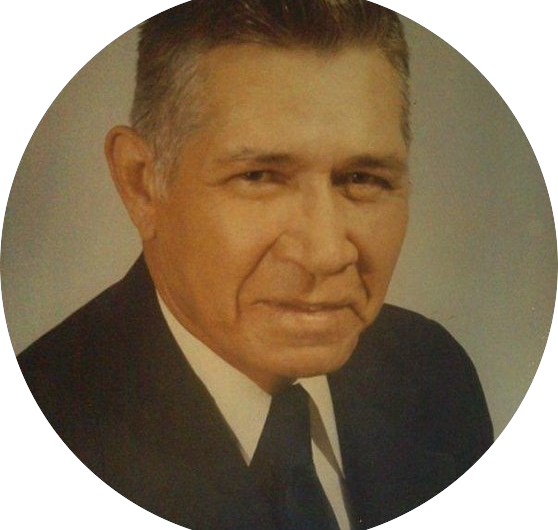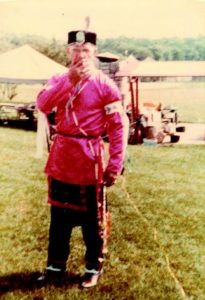 From this Corner
From this Corner
Chief James Greenfeather
FROM THIS CORNER
By
Glenna J. Wallace
JAMES GREENFEATHER: BEFORE AND AFTER

He served four short years from 1974 -1978 but the Eastern Shawnee Tribe of Oklahoma was forever
changed after James Greenfeather was elected as the sixth Chief following reorganization in 1939.
Before James Greenfeather became Chief, the tribe had 58.19 acres, no buildings, no enterprises, no
developments. Business was conducted in offices located in Miami, OK over Dawson’s Jewelry Store.
Business Committee meetings and General Council were held in the Ottawa County Courthouse Annex
or elsewhere. Perhaps it was the 1976 bicentennial preparations and celebrations held in honor of the
birth of this great Nation that helped energize all tribes in the area including the Eastern Shawnee;
perhaps it was the personality and leadership style of Greenfeather; and perhaps it was a combination
of both– but dramatic changes did occur while he was Chief.
James Isaac “Big Boy” Greenfeather was born July 18, 1920 to Luther Oce Greenfeather and Blanche
Bluejacket Hawk. His maternal grandparents were Charles, Jr. and Carrie Elizabeth (Foreman)
BlueJacket. James or Big Boy was the oldest of three children born to Luther and Blanche. His siblings
were Lois (Cissy) Greenfeather Nowlin and Alonzo Greenfeather. James also had several older half
brothers and sisters from his mother’s previous marriage to Frank Bear. These included Wynona Evelyn
Bear Hollandsworth, Edgar Lee Bear, Richard Vance Bear, Thurman Walker Bear, Herman Wilfred Bear
and Lucy Nadine Bear Captain. Additionally he had AJ, Carl and Roy Greenfeather as half-brothers from
another marriage of his father’s..
Big Boy attended Wyandotte Indian or Seneca Indian School , completing the 10th grade. Always
athletic, Big Boy tried out for the Brooklyn Dodgers Professional Baseball Team but a broken ankle cut
that career short. He was also a professional boxer.
At the age of 18, Big Boy enlisted in the Army where he served four years. His military duties took him
to North Africa and Sicily. Wounded more than once, he was awarded the Purple Heart for his bravery
during the World War II period.
James married Esteline Kist and they became parents of Thurman James Greenfeather, often times
called Little Jim. James and Esteline divorced and Little Jim went to live with his grandmother Mary
Francis Beaver Kist at the age of 3 or 4.
Married several times, James also had one other son, Herman Jay Greenfeather who currently lives in
Florida. Although Little Jim lived with his maternal grandmother, he states he had lots of contact with
his father and has all good memories of him.

Chief James Greenfeather
James Greenfeather had a way with words and actions. Little Jim remembers his father as being
headstrong while at the same time having a gentle side. Jim states his father never talked mean to him,
never laid a hand on him. Big Boy realized that more could be gained by scolding his son than spanking
him. Son Jim recalls his father saying, “If you’ve got something to say, well say it and get it off your
chest. If you see a person you don’t like, stay away from him. Speak to people you don’t necessarily
care for but let it end there.” And if it didn’t end there, James took care of that too. He didn’t let
anyone sway him or intimidate him. He could be up for a good fight. He was Chief at a time when men
still invited men outside to settle their political differences. James let it be known that he wasn’t afraid,
that he was prepared to defend himself and his ideas if he had to and he was going to run the meetings.
Some of those meetings were notorious for less than mild behavior, from women as well as men.
Before and after could also refer to James’ drinking. It has been a pattern in so many Native American
lives. Before he stopped drinking, he had a temper. Before he stopped drinking he went through
several marriages. Before he stopped drinking, he would argue. Before he stopped drinking if he lost
his temper, look out!
Son Jim pointed out that after his father stopped drinking, he straightened up, mellowed out. No longer
would he argue. Instead he would just laugh at you. It was at this time in his life even though he was
still an over the road truck driver that he became easy going. He spent lots of time with son Jim, even
making a saddle together which is on display in our museum today. Proud of his Shawnee heritage, he
was a stomp dance leader at White Oak, dressed in regalia, participated in sweats, and did whatever he
wanted to accomplish. Little Jim’s face lit up as he proclaimed, “What a great guy he was to me in later
years. He treated me like I was special.”
James Isaac Greenfeather became Chief of the Eastern Shawnee Tribe of Oklahoma in 1974. Shortly
thereafter the tribal newsletter The Shooting Star made its debut. For those of you who might not
know, Tecumseh means “shooting star”. In 1975, the Intertribal Council (ITC) obtained an Indian Grant
to design and construct tribal flags to participate in the Bicentennial Celebrations. All the ITC tribes
began the process of developing tribal flags. Jim Greenfeather embroiled himself in extensive research,
enlisted the aid of Robert Alexander who is credited with designing the logo along with Clark Frayser and
George Phelps who wrote a play about Tecumseh entitled The Panther and the Swan. This production
was staged in August 1976 with Greenfeather appearing in the production. A tribal flag and a tribal play
can be attributed to the efforts of James Greenfeather as well as the initiation of Miami Heritage Day.
In 1977 Greenfeather led the tribe in securing its first grant—obtained through the Department of
Commerce at no cost to the tribe. Groundbreaking was held December 2, 1977. A contractor was hired
to construct an industrial building. Son Jim said it was his father’s idea to get a contract with someone
in the east to build stainless steel sinks in hospitals. This was news to me as I had always heard the
building was built to house a truck driving school. The contractor hired to construct the industrial
building disappeared, leaving an unfinished building which Greenfeather had hoped to name The
Tecumseh Building and $31,000 in unpaid bills. Ultimately the bonding company took care of the unpaid
bills but the building project was never completed for its original purpose. The red barn metal building
sat unfinished, vacant until 1984 when entrepreneur David Allen entered into contract with the Eastern
Shawnee Tribe of Oklahoma, remodeled the building and turned it into a Bingo Hall, our initial venture
into gaming. Greenfeather died in May 1983 prior to the December 7, 1984 opening without seeing the
building utilized. Nevertheless, had he not taken the bold leadership steps he took, we might not be
where we are today.
In 1978 the tribal park and recreation area was developed and named Tecumseh Park. Playground
equipment from the Seneca Indian School was moved to this location which is now part of the
Ceremonial Grounds. Also In 1978 plans were initiated to build a second building on the 58.19 acres,
this time our original administration building. Following the construction of the BlueJacket Center in
1992, that building came to be known as the Education Building, now in 2013 housing the Gaming
Commission.
Before James Greenfeather the Eastern Shawnee people dreamed of a time when they would have their
own meeting spaces, their own enterprises. Each Chief contributed to advancing the tribe to the point
that the dream could become reality. Each held on, paving the way for the next Chief. Before James
Greenfeather, it was a tribe with 58.19 acres with a dream of development. After James Greenfeather
the tribe had a newsletter, a seal, a flag, a play, buildings that were not yet occupied but could be seen
and would one day be used for the good of the Eastern Shawnee Tribe of Oklahoma and its people. The
dream continues.
Information based upon interview with Jim Greenfeather, History of Ottawa County by Velma
Nieberding, tribal records and personal information.